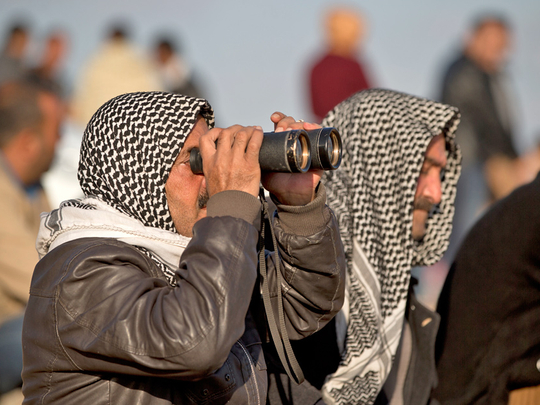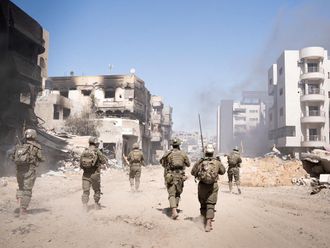
It will take a while to save the Syrian Revolution and usher in a long and painful reconstruction era, but the task is both doable and necessary — even if more recent developments, which added to existing woes, significantly complicated matters.
As the current Syrian National Coalition (SNC) President, Hadi Al Bahra, acknowledged, revolutionary forces committed numerous mistakes since the beginning of the uprising in early 2011. Al Bahra told the pan-Arab daily Al Sharq Al Awsat that “the Syrian people were not experts in revolution”, and that this was the first that was undertaken in half a century. And this, allegedly, accounted for the errors he vowed to fix. Remarkably, the unfortunate characterisation illustrated a major disconnect between SNC leaders and brave fighters who risked life and limb on the battlefield. Of course, and while it was true that the Baath regime stifled all independent thinking for more than four decades, which presumably stripped Syrians from such skills, one did not need “expertise in revolution” — whatever that may be may — to stand against oppression. Rather, one mobilised the nation to restore liberty, something that Syria experienced in the first half of the 20th century when brave leaders stood against colonial rule.
Al Bahra did not reveal whether he lamented that the SNC wasted precious time to define itself as well as the opposition. In fact, it took a while after 2011 for the SNC to emerge as a revolutionary organisation, because typical traditional political dissenters focused on President Bashar Al Assad instead of saving Syria. As local organising committees formed in April 2011, protesters grouped together youths from the working and middle-classes, which included both men and women from diverse religious and ethnic communities. Most were wary citizens who sought freedom and improvement in their lives. They were neither ideologically motivated nor anxious to overthrow the regime. What they aimed at was for nonviolent efforts to improve living conditions.
Everything changed after July 2011 when Damascus responded with force, which prompted opposition groups to unite in the SNC that, regrettably, fell into a vicious cycle of internal power-struggles. To some extent, that was to be expected because the SNC grouped such disparate groups as the Muslim Brotherhood, the Coalition of Secular and Democratic Syrians, the Arab National Democratic Rally, the Kurdish Democratic Alliance, the Syrian Democratic People’s Party, the Syrian Turkmen Assembly and dozens of others.
Unfortunately, SNC meetings in foreign capitals turned into Towers of Babel, wherein bickering was a constant feature among affable academics who harboured idealised goals and wily politicians anxious to gain power for its own sake. Professors Burhan Galioun and Bassma Kodmani, atypical Syrians who actually gave some thought to what the country could look like, were no match for Abdul Baset Sieda, George Sabra, Moaz Al Khatib, Ahmad Jarba, Gassan Hitto, Hassan Abdul Azim, Fares Tammo, Radwan Ziadeh, Riyad Al Turk, Riad Al Assad and many others. For months on end, nearly 100 senior “leaders” argued amongst themselves, confirming once again that generals almost always lost wars when they adopted competing agendas.
By now, it should be amply obvious that SNC representatives ought to end existing differences, settle for a permanent president — who would consult with no more than a handful of advisors until such time when the revolution achieves its goals — and whose only aim would be victory. There will be plenty of time to sort out differences at later stages, since reconstructing Syria was a century-long proposition where every talented Syrian would find room to add value.
Al Bahra told Al Sharq Al Awsat that the SNC did not see itself as an alternative to the regime but was, rather, interested in achieving the demands of the Syrian people without defining what those might be. He reiterated that the SNC backed a “political solution” to the Syrian crisis, affirming “that there was no room for a military solution and the problem was with the Al Assad regime that was convinced that the only [answer] was a military one, and that it could resolve the situation through military might”.
This was the heart of the problem and an avowal of the opposition’s bankruptcy as an effective revolutionary voice. After four years in what slowly became a war with no end in sight, after more than 200,000 dead and countless wounded, after millions of refugees, and after the wholesale destruction of the country, “President” Al Bahra sought a political solution with a foe determined to crush each and every soul that opposed it. This posture was so infantile that one wondered whether Al Bahra believed Damascus was ready to simply turn over the keys to the SNC.
Indeed, it was safe to conclude that the SNC’s reticence helped the Al Assad regime as the latter concentrated on fighting Jabhat Al Nusra and Daesh (Islamic State of Iraq and the Levant) instead of the Free Syrian Army, especially after Damascus saw some utility to share this objective with the rest of mankind.
Al Bahra called for additional aid allegedly because he was presumably fighting two enemies although he only wanted to destroy one and find a political solution with the second. While it was worthwhile that the SNC dealt “with both these threats cautiously and with full awareness”, the only way to save the Syrian Revolution is to look for a genuine patriot who is ready to lead the nation. Short of that, the hapless Syrian nation is condemned to suffer far longer than many had assumed.
Dr Joseph A. Kechichian is the author of the forthcoming Iffat Al Thunayan: An Arabian Queen, London: Sussex Academic Press, 2015.










